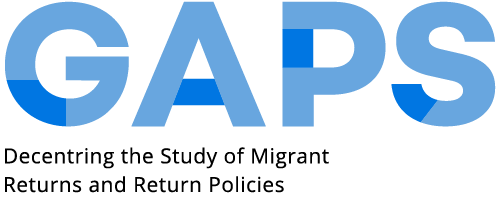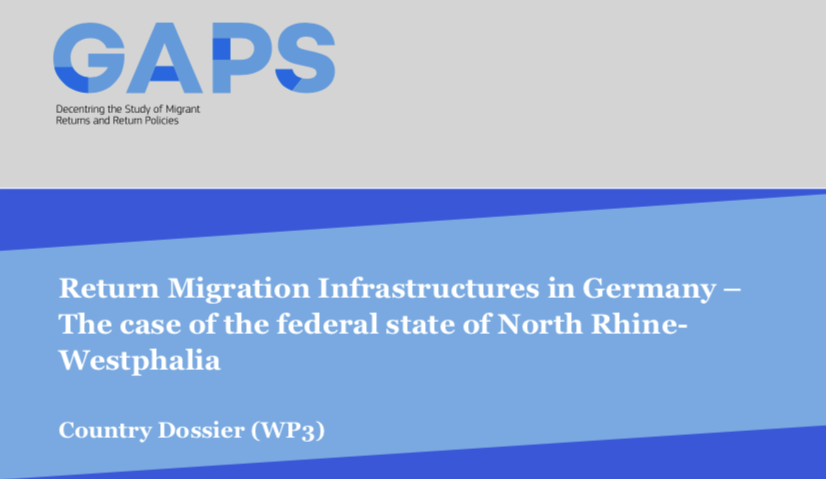Return Migration Infrastructures in Germany – The Case of the Federal State of North Rhine-Westphalia
Executive Summary:
This Country Dossier on Germany presents an overview of the assisted and forced return migration infrastructures (RMIs) in Germany, focusing on the most populous federal state of Germany, North Rhine-Westphalia (NRW), as a case study. It examines how return migration governance is put into practice through the concept of RMIs. Federalism in Germany grants autonomy to local governments, and federal law assigns responsibility for return policies to municipal authorities. This leads to complex coordination among institutions that decide independently on procedures and technologies. Consequently, the staff of the foreigners authorities (Ausländerbehörden, ABHs) are often isolated when implementing decisions they did not make and are faced with the conflicting demands of overseeing integration and return.
The extended case study on NRW highlights how the RMIs and forced returns in particular, are implemented by describing the actors involved, their practices (“doings”), the materials and technologies used, the relationships between them and several perceived tensions and ‘gaps’. A broad network of actors involved at different levels emerges, such as those who either facilitate or contest return, others who maintain a dual role, actors with an entrepreneurial approach to the operation of (forced) return, and individuals.
Assisted and forced return procedures are institutionally designed to follow a linear logic; however, non-linearity is very common depending, for example, on the dispositions of migrants, the attitudinal ‘cultures’ in foreigners offices and the strength of local civil society. Moreover, there is a considerable overlap between forced and assisted return in terms of actors/ institutions, activities and technologies, which suggests that the distinction between so-called voluntary assisted return and forced removals is not a strict one but rather a continuum connecting the two. Several practices emerge in grey areas. With the efforts to streamline service providers and the centralisation of institutional support through newly created institutions in NRW, overlaps, including in funding structures, are becoming more pronounced. In both RMIs there is an increasing reliance on Frontex for organisational and procedural tasks but also for funding.
For the forced removal infrastructure, the study revealed a continuum of attitudinal practices among actors, which dilutes the binary between facilitating and contesting actors, as the latter may not oppose forced removals but simply advocate for their enforcement in a more humane manner. Those who categorically reject and oppose forced return usually have no institutionalised support and minimal financial resources. Similarly, within the assisted return migration infrastructure, attitudes towards forced return range from opposition to scepticism to pragmatic acceptance, but contestation tends to be more about the means rather than the ends of RMIs. State technologies of control include opacity and the diffusion of responsibility through the regular issuance of new legal restrictions on foreigners and an increase in bureaucracy.
The implementation gaps in NRW’s return infrastructure are numerous. They can be categorised into three pillars. First, in the field of practical enforcement of returns there are challenges due to limited monitoring and the structural overburdening of foreigners authorities. The second is about the preconditions in the NRW context in terms of lack of minimum standards versus overly restrictive regulations, a lack of sincerity, impartiality and transparency, as well as the outsourcing of responsibility. The third are federal-level frameworks as a norm-setting context where we see legislative hyperactivity in Germany that remains without effect, and the autonomy of local government. The gaps seem to result from the search for solutions in ever more institutional innovations and legal adaptations with endless exceptions and new detailing of case possibilities, leading to an administrative–bureaucratic deadlock and inefficiency. Gaps in monitoring, and the outsourcing of responsibility for returnees by handing them over at departure/ arrival in the destination country, pose high risks in terms of the protection of rights but are largely ignored. The reasons for this are speculative, but it is likely that a mixture – consisting at least of a lack of political will and a lack of capacity in the face of bureaucratic and decision-making deadlocks on the one hand and an overload of staff and mandates on the other – accounts for the current situation.
The focus on the perceived need for quicker and ‘more effective’ returns in German political debates has rendered assisted return largely invisible. While some providers seek to promote its benefits, others fear that increased publicity will lead to increased scrutiny and controversy. The landscape of assisted return has developed into a patchwork of practices without a solid legal foundation, while the current discourse favours harsh measures despite their financial and human costs. Recent federal calls for more forced removals, and increasing pressure, especially financial insecurity, on non-state actors in NRW, have left stakeholders sceptical about the future of assisted return in general or the role of non-state providers in it. Moreover, there is a clear trend towards state institutions taking more control of the process in forced removals and assisted return at the federal level and in NRW, e.g., through the establishment and increased role of interface institutions, centralisation efforts and shifts in return counselling.
Please find the entire DOI report by clicking the button below:

